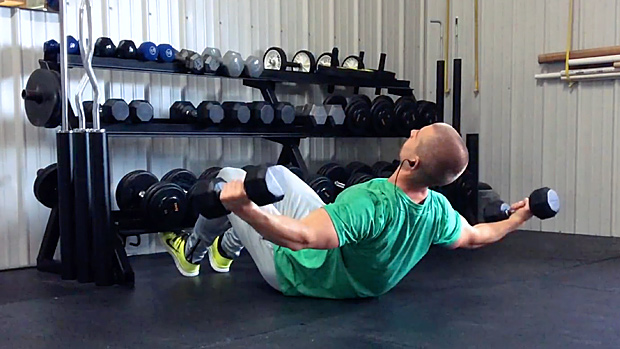Who Wants to be Strong and Slow?
So you think you're strong, huh? You go to the gym, squat 700 pounds and call it a day. Not bad, but the real question is, are you strong and fast? Many lifters who are strong squatters by American standards (greater than 700 pounds) might disregard the need for more explosive strength and say it's not all that important. They're dead wrong!
Traditional weight training techniques such as the "5 x 5" method are effective but will make you miserably slow unless you incorporate some speed work on a weekly basis. Who cares how strong you are if it takes a millennium for your muscles to produce maximal strength! You need to get strong and fast!
Make no mistake about it, strength without speed is useless. Unless you learn to train the muscular system to act explosively, your ultimate potential will always be out of reach. In his phenomenal book, Science and Practice of Strength Training, Vladimir Zatsiorsky sums it up perfectly, "Strong people do not necessarily possess explosive strength."
After applying the following techniques for the squat, your increased explosive strength will help you blow away the competition, whether it be your opponent, training partner, or your girlfriend's father who caught you in her bedroom a little too late one night. Improving your explosive strength could be the difference between making the lift in a squat competition or making it over the fence in your girlfriend's backyard!
In order to improve explosive strength, you must understand its components: maximum strength, starting strength, and acceleration strength. Since maximum strength is improved through more traditional methods (such as the 5 x 5 method), this article will focus on increasing starting and acceleration strength.
Starting strength is the ability to develop force before the load moves. A good example would be the box squat. When you're in the seated position (on the box), many muscles are briefly relaxed. The development of muscular force before the load moves again is referred to as starting strength.
Acceleration strength is the ability to achieve maximal external force in a very short amount of time. It's easy to see if a lifter has good acceleration strength because the speed of the load will increase rapidly after restarting the movement.
These are the two neglected components of explosive strength. The following technique will be aimed at dramatically improving each phase.
The Case for the Jumping Box Squat
As mentioned in one of my previous articles, barbell training can be somewhat limiting when attempting to improve explosive strength since the load can't be released (in other words, you have to decelerate near the top of the lift so you don't lose your balance and fall out the window into traffic below). Don't get me wrong, explosive strength can be improved using barbells, especially if the trainee has been performing all his movements "slow and controlled." Simply lowering the load to 50% of 1RM (one rep max) and lifting quickly will help. But what I'm going to do is show you an even better option!
Based on the previous information, you should now realize a few things. First, the movement must be performed extremely fast. Second, the load must be light enough to allow an explosive tempo. Third, there must be a "continuation" of force. In other words, the movement shouldn't be something the body must slow down as you approach lockout in order to protect the joints.
The exercise I'm going to show you requires very little equipment; in fact, you could probably do this movement in the comfort of your own cardboard box while watching reruns of Sex and the City. I call them Jumping Box Squats.
Test and Technique
Before reading any further, I want you to perform a simple test. Ready? Alright, stand up and get your body in position as if you're going to jump as high as you possibly can. Get crouched down like you're getting ready to jump up. I'm not kidding, get off your glutes and do it! Imagine I'm holding a certificate for a date with Britney Spears and your best friend's girl you lusted over in high school! Get ready to jump for it.
Now, look down at your feet. This is your strongest jumping stance given your present level of strength development. Next, I want you to measure the distance between the inside of your heels at this position.
I know what you're thinking, "I'm going to use this stance to perform the jumping box squats!" Sorry Bubba, but I'm a step ahead of you. This is the stance you need to avoid! Why? Because it's your strongest stance. In order to get really strong you must train where you're weak. Makes sense doesn't it?
Now that we have your foot stance information, let's focus on the technique:
Step 1 – Select a box, bench or even a chair that allows the hip joint to drop two to three inches below the height of the knee when seated. Sit down on it.
Step 2 – Place the heels six inches wider than the number you got in the test above (i.e. your strongest position.) I want your heels six inches wider than this value for half of the sets and six inches narrower for the other half. The knees should remain directly in-line with the feet. Don't let them buckle together.
Step 3 – Position your feet so the angle of the knee joint is approximately 100 degrees. This is an average value, no need for a goniometer. But, the knee joint must be greater than 90 degrees!
Step 4 – Clasp your hands behind your head (like the time in high school when you had a major "Beer & Babes Bash" when your parents were out of town and got a surprise visit from the local authorities). The reason the hands are behind the head is because it takes the arm swing out of the movement, thus minimizing cheating. I don't want any assistance from the momentum of swinging arms generated by the anterior deltoids. Also, it mimics a shoulder position somewhat similar to the barbell squat.
Step 5 – Flex forward at the hip so your trunk is approximately 60 degrees relative to the floor. The lower back should be arched and tight. Your chest should be held high. Don't let the trunk flex forward any more than 60 degrees throughout the entire movement. If it does you're cheating and only hurting your progress.
Step 6 – While focusing on applying maximum force through the heels (keeping the stress on the glutes and hamstrings), jump up as explosively as you possibly can. Apply maximum force as if you were performing a 1RM squat! Don't let the trunk rock forward before jumping up. This will take some practice but it's the most important point.
Since there's no extra external load, all the variables need to be perfect. You'll notice when many lifters perform box squats they rock their trunk back at the bottom (while seated) and then rock it forward, building up momentum in order to lift the load. Don't do that! As many strength coaches have already stated, the first action that should take place when reversing the motion at the bottom of a full squat is the head/upper back/trunk region should extend back into the bar, not flex forward!
Think about it, rocking the trunk forward teaches your nervous system to do the same at the bottom of the squat when reversing the movement. Do you know what happens when your trunk shifts forward before your hips raise at the bottom of a maximum squat? Let's just say it ain't pretty.
Step 7 – After being airborne and coming back to terra firma, lower yourself quickly (but under control) back to the starting position. Repeat for two more repetitions before resting. Remember, no momentum. All three reps should be smooth and continuous without any abrupt changes in tempo.
The Plan
Here are the parameters for developing explosive strength:
Exercise: Jumping Box Squats
Sets: 8-12
Reps: 2-3
Tempo: Take one second or less to lower yourself, jump up as explosively as you can
Rest: 60 seconds
Load: Bodyweight for beginner and intermediate lifters, advanced lifters place 20% of total bodyweight on a barbell across upper back as if squatting
Frequency: Once each week
As a progression, I want you to lower the height of the box, bench or whatever else you're using two inches every other week (or every third workout). Keep lowering it until you reach a level only six inches off the ground. Once you reach six inches, repeat the sequence at the original height and start the progression over. At this point you can add a load representing 20% bodyweight to a barbell, but if it slows down your tempo, then you aren't ready for an external load. Remember, speed of execution along with applying maximum force is most important, not the load!
This exercise should be immediately followed by maximal strength training techniques targeting the lower back, hip, hamstring and abdominal region. Alternate this session each week with another lower body session that focuses on maximum strength and hypertrophy development. Since jumping box squats also serve as an excellent restoration exercise, I recommend you perform them as your second lower-body workout each week. Even though the assistance exercises are for developing maximal strength levels, you should still attempt to move the load quickly. A sample lower body routine would be as follows:
Monday
Good Mornings
3 sets x 3 reps
Rest: 180 seconds
A1 Dumbbell Side Bends
5 sets x 5 reps
Rest: 90 seconds
A2 Pull-throughs
3 sets x 12 reps
Rest: 90 seconds
(Those A1, A2 designations basically mean to superset these exercises.)
B1 Decline Sit-Ups
5 sets x 5 reps
Rest: 90 seconds
B2 Reverse Hypers
2 sets x 20 reps
Rest: 90 seconds
Thursday
Jumping Box Squats
10 sets x 3 reps
Rest: 60 seconds
A1 Hanging Leg Raises
4 sets x 5 reps
Rest: 90 seconds
A2 Glute/Ham Raise
4 sets x 5 reps
Rest: 90 seconds
B1 Overhead Cable Crunches
4 sets x 5 reps
Rest: 90 seconds
B2 Back Extensions
4 sets x 5 reps
Rest: 90 seconds
Editor's note: This is just a sample program, feel free to add jumping box squats into just about any program and you'll like the results. If you aren't familiar with some of the exercises in the sample program, just type the name into the search engine and you'll find some explanations and perhaps some pics.
Conclusion
Use these techniques to overcome the competition or that fence in your girlfriend's backyard. Either way, you'll be glad you performed this movement. Best of luck!




